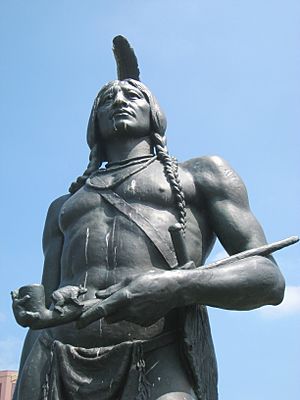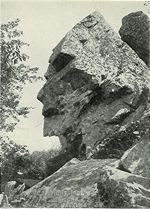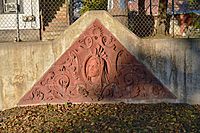Massasoit facts for kids
Quick facts for kids
Massasoit
|
|
|---|---|
| Ousamequin | |

Sculpture of Ousamequin in Mill Creek Park, Kansas City, Missouri by Cyrus E. Dallin
|
|
| Wampanoag leader | |
| Succeeded by | Wamsutta |
| Personal details | |
| Born |
Ousamequin
c. 1581 |
| Died | 1661 (aged 80) |
| Children | Wamsutta, Metacomet |

Massasoit Sachem (born around 1581, died 1661) was a very important leader of the Wampanoag people. His real name was Ousamequin. The word Massasoit actually means Great Sachem, which is a title for a powerful chief. The English colonists thought it was his name, and so it became what he was known by.
Massasoit's people had been greatly weakened by many diseases. This made them open to attacks from the Narragansett tribe. To protect his people, Massasoit formed an alliance, or partnership, with the English colonists at Plymouth Colony. Thanks to his help, the Plymouth Colony survived its difficult early years and avoided starvation.
Contents
Meeting the English at Plymouth
When the Pilgrims arrived in Plymouth, the Wampanoag people, also called the Pokanokets, lived in a large area. This area included parts of Rhode Island and much of southeastern Massachusetts. Massasoit lived in a village called Sowams, located in Warren, Rhode Island. He was the main leader for many smaller Pokanoket chiefs. In 1621, he sent a man named Squanto to live with the colonists in Plymouth.
Before the Pilgrims arrived, many diseases had badly affected the Pokanokets. Massasoit wanted to form an alliance with the new English colonies to protect his people from the strong Narragansett tribe. The Narragansetts lived west of Narragansett Bay in Rhode Island. Massasoit sent Samoset, another Native American leader, to meet the colonists. Samoset had learned English from fishermen. Massasoit wanted to know if the English were friendly.
Massasoit created important friendships and political ties with colonial leaders. These leaders included William Bradford, Edward Winslow, Stephen Hopkins, John Carver, and Myles Standish. They signed a peace treaty on March 22, 1621. This alliance helped the Pokanokets stay neutral during the Pequot War in 1636. English records show that Massasoit's help was key to the survival of Plymouth Colony. He prevented the Pilgrims from starving in their first years.
A Lasting Alliance with the Colonists
There were some disagreements between Massasoit and the colonists. One issue was that the colonists would not give up Squanto, whom Massasoit felt had betrayed him. This problem was solved in March 1623. Massasoit became very sick, and Edward Winslow cared for him until he recovered. After getting better, Massasoit told Winslow, "the English are my friends and love me... whilst I live I will never forget this kindness they have showed me."
In return for their kindness, Massasoit warned the Pilgrims about a plot against them. He had learned that some powerful Massachusett warriors planned to attack both the Wessagusset Colony and Plymouth colonies. Massasoit warned the Pilgrims in time, saving them.
As the English colony grew, the colonists needed more land. This caused some tension in the alliance. To keep the peace, Massasoit sold a large piece of land to Myles Standish and others from Duxbury in 1649. This sale happened at Sachem Rock, a special rock formation near the Satucket River in East Bridgewater, Massachusetts. This site is now listed on the National Register of Historic Places.
Massasoit's Children
Massasoit had five children. His sons were Wamsutta, born between 1621 and 1625; Pometecomet, also known as Metacomet or Metacom; and Sonkanuchoo. His daughters were Amie and Sarah. After Massasoit died, Wamsutta and Metacomet visited Plymouth. They asked the Pilgrims to give them English names. The court named Wamsutta "Alexander" and Metacomet "Philip."
Wamsutta, the oldest son, became the sachem of the Pokanokets after his father's death. However, he died within a year. His brother Metacom then became the leader in 1662. Amie married a man named Tispaquin. She was the only one of Massasoit's five children to survive King Philip's War in 1676.
Massasoit's Legacy
Roger Williams had to leave the Massachusetts Bay Colony to avoid being arrested. He spent the winter of 1635–36 with Massasoit. The next spring, Massasoit gave him land along the Seekonk River. Governor Winslow advised Williams to move his settlement to the other side of the river. This was because his current spot was inside Plymouth Colony's land. Williams followed this advice and founded Providence Plantations, which later became part of the Colony of Rhode Island and Providence Plantations.
The peace that Massasoit worked so hard to keep for fifty years ended soon after he died. His son Wamsutta did not continue his father's peaceful approach. Instead, he started an alliance with Connecticut Colony.
Massasoit was known as a kind and honest leader. He always kept his promises and tried to encourage his people to love peace. He also kept the Pilgrims informed about any plans other tribes had against them. It is not clear exactly when Massasoit died. Some say it was as early as 1660, while others believe it was as late as 1662. He was likely between 80 and 90 years old when he passed away.
Wamsutta died suddenly within a year of becoming sachem. Massasoit's second son, Metacom, then became the leader of the Pokanokets and the main chief of the Greater Wampanoag Confederacy. Metacom believed that Wamsutta had been murdered by the colonists. This belief was one of the reasons that led to King Philip's War, which was one of the bloodiest wars in early American history.
There are several statues of Massasoit. One famous statue by sculptor Cyrus E. Dallin stands near Plymouth Rock. Other statues can be found outside the Utah State Capitol building, at Brigham Young University, at the Springville Museum of Art in Springville, Utah, and in Kansas City, Missouri. In Massachusetts, both Massasoit Community College and Massasoit State Park are named after him.
See also
 In Spanish: Massasoit para niños
In Spanish: Massasoit para niños




